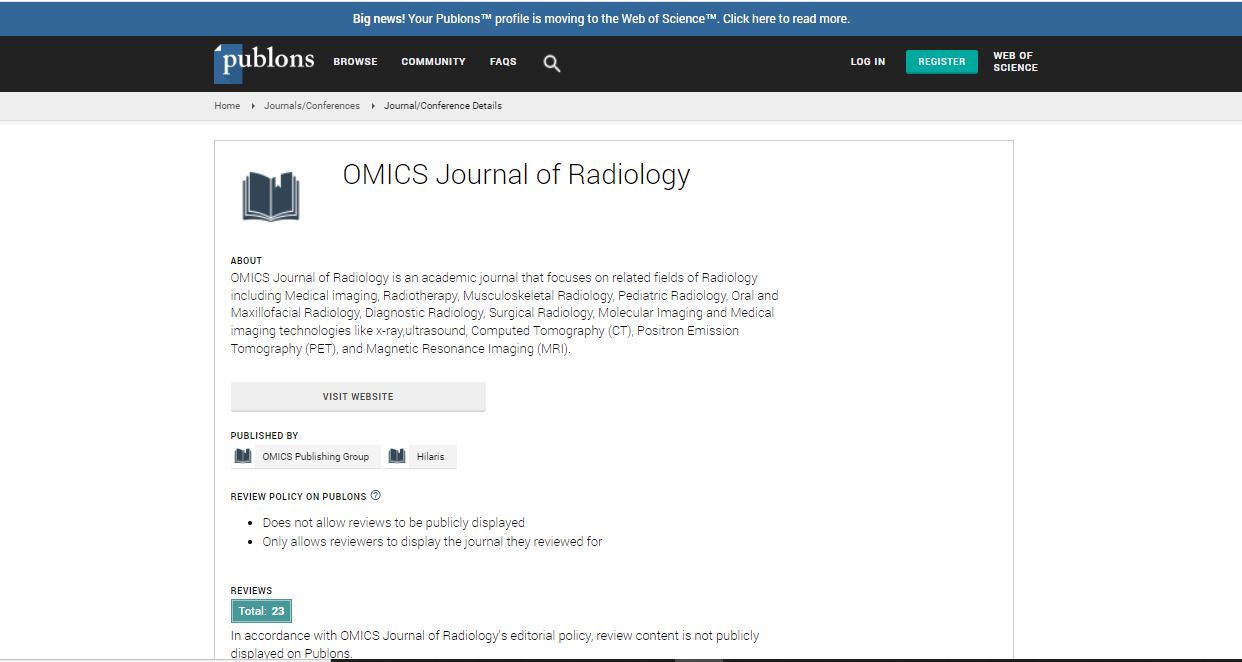Our Group organises 3000+ Global Conferenceseries Events every year across USA, Europe & Asia with support from 1000 more scientific Societies and Publishes 700+ Open Access Journals which contains over 50000 eminent personalities, reputed scientists as editorial board members.
Open Access Journals gaining more Readers and Citations
700 Journals and 15,000,000 Readers Each Journal is getting 25,000+ Readers
Google Scholar citation report
Citations : 551
Journal of Radiology received 551 citations as per Google Scholar report
Journal of Radiology peer review process verified at publons
Indexed In
- Index Copernicus
- Google Scholar
- Open J Gate
- Genamics JournalSeek
- ResearchBible
- Electronic Journals Library
- RefSeek
- Hamdard University
- EBSCO A-Z
- OCLC- WorldCat
- SWB online catalog
- Virtual Library of Biology (vifabio)
- Publons
- Geneva Foundation for Medical Education and Research
- ICMJE
Useful Links
Share This Page
Liquid crystal contact thermography in breast cancer detection
World Congress on Radiology and Oncology
Pawel Basta, Jan Skupien, Tadeusz J Popiela, Agnieszka Byszek, Anna Cwierz, Diana Hodorowicz-Zaniewska, Piotr Kasprzak, Agnieszka Kotlarz, Wojciech Rudnicki and Marcin Trzyna
Jagiellonian University, Poland Oncological Centre-Cracow Branch, Poland Lower Silesian Oncology Center, Poland Braster S A Company, Poland
ScientificTracks Abstracts: OMICS J Radiol
Abstract
Introduction: The most efficient way to decrease breast cancer-related mortality is its early detection. Thermography is an imaging method postulated to detect neoplasms through tumor cell√ʬ?¬?s increased metabolism in comparison to healthy cells. Despite some promising results, thermography has not been, so far, accepted as valuable breast lesions detection method, mainly due to a lack of standardized protocols and conditions of performing the examination and poor quality of many research articles undermining credibility of obtained results. A device called Braster Tester has been developed to provide high-quality contact thermography images of the breast. A controlled, prospective observational study has been designed to determine the credibility of the new technology. Aim: The aim of this study was an evaluation of the diagnostic accuracy in detection of breast pathology with the technology of the liquid crystal contact thermography. Method: A liquid crystal contact thermography was performed by 274 women referred to breast pathology outpatient units for verification of abnormal, either breast ultrasound or mammography examination. The final analysis included 95 women aged 25√ʬ?¬?49 years with BIRADS-US 4 or 5 category in breast ultrasound scan (Arm A), 73 women aged √ʬ?¬•25 years with BIRADS-US 1 or 2 category in breast ultrasound scan (Arm B), and 87 women aged √ʬ?¬•50 years with BIRADS-US 4 or 5 category in breast ultrasound scan (Arm C). The parameters for assessing the effectiveness of the liquid crystal contact thermography: C-statistic, sensitivity, specificity and diagnostic accuracy defined as the proportion of true positives and true negatives. Among all thermographic, results were calculated using exact McNemar√ʬ?¬?s test and Wald√ʬ?¬?s test in respect to final pathology reports of the breast specimens. Results: The diagnostic efficacy of the liquid crystal contact thermography defined as above demonstrated a sensitivity of 81.5% (95% CI: 64.1; 92.6) and specificity of 87% (95% CI: 79.7; 92.4) in women <50 years of age and sensitivity of 77.8% (95% CI: 67.2; 86.2) and specificity of 62.5% (95% CI: 48.5; 75.1) in women √ʬ?¬•50 years of age. In the group of women without breast pathology (BIRADS 1 and 2), the rate of false-positive thermography was similar to that observed in women with abnormal breast ultrasound without breast cancer (22.5% and 37.5% in women <50 and √ʬ?¬•50 years of age, respectively). Conclusions: The results of this study illustrate promising trends and an accepted efficacy of liquid crystal contact thermography in highlighting women with a higher risk of breast pathology, especially breast cancer. This statement is more evident especially in woman <50, thus the technology may have a chance to support other modalities in that goup of women in breast cancer prevention.Biography
Dr Pawe√?¬? Basta is an experienced gynecologist-obstetrician. He graduated from the Faculty of Medicine, Collegium Medicum in Cracow. In 2007 he completed his specialization in obstetrics and gynecology at the Jagiellonian University in Cracow and in 2013 he completed specialization in oncology gynecology also at the Jagiellonian University in Cracow, however as a part of his studies he worked as an assistant at a prestigious University College London Hospital in the United Kingdom. He is a recognized doctor specialized in the early detection of breast cancer and in the malignant neoplasia of the female reproductive system. He enjoys the respect and trust of patients who underline his commitment to his work and his willingness to help, as well as the individual approach to each patient and his or her problem. Dr Pawe√?¬? Basta is also an academic teacher of the Medical Faculty and Medical School for Foreign Students of the Jagiellonian University Medical College. Moreover, Pawe√?¬? Basta is an author and co-author of numerous medical publications. He was also a speaker at many medical conventions, conferences and meetings taking place both in Europe and the U.S.

 Spanish
Spanish  Chinese
Chinese  Russian
Russian  German
German  French
French  Japanese
Japanese  Portuguese
Portuguese  Hindi
Hindi 
